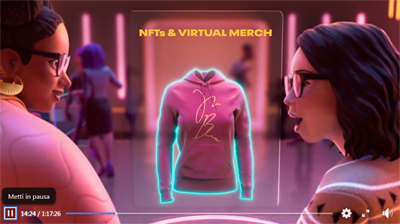The metaverse, trademarks and intellectual property: opportunities and risks
What is the metaverse, and why understanding its opportunities and risks is important for the holders of trademarks, designs and other intellectual property rights.
What is the metaverse
The term “metaverse”, first used by Neal Stephenson in his book “Snow crash” in 1992, is currently used to define a parallel universe formed by online platforms in which the user, through a virtual ego called “avatar”, can explore spaces and experiences – which the user can customise to a varying extent – thanks also to the use of virtual reality (VR) and augmented reality (AR) technologies. In the metaverse the avatar can share experiences with other users, as is already happening on Roblox, a gaming platform, or on Decentraland, a VR platform based on blockchain technology in which anyone can create and monetize environments and applications.
The metaverse is actually the next step after the creation and spread of social platforms, that leads beyond those platforms, incorporating them.
Meta’s idea of metaverse

Two avatars browse virtual merchandise in Meta’s video presentation of its metaverse project.
Among those busy working at the metaverse there is Meta, known as Facebook Company until 28 October 2021 when CEO Mark Zuckerberg announced the change of name. All platforms owned by Facebook Company (Facebook, Messenger, Instagram, Whatsapp, YouTube) are now part of Meta. The new company’s stated objectives include creating the metaverse and “growing businesses”.
Mr. Zuckerberg’s idea of metaverse is explained and shown in a video that effectively illustrates the potential marketing and buying experience opportunities this idea can offer.
The adjective Mr. Zuckerberg uses frequently to describe the metaverse is “immersive”: avatars will move around in extremely realistic and totally customisable environments.
The user-avatar will have the opportunity to create a virtual home, furnish and decorate it, own a wardrobe of virtual outfits for all occasions, enjoy sports and many other activities virtually, sharing spaces and experiences with other users. It will also be possible to search and, as is easy to foresee, buy everything an avatar might need to furnish, decorate, dress, play etc.
The opportunities
The video mentioned above clearly shows how this “immersive” metaverse, of which Mr. Zuckerberg’s project is just one variety, carries important potential for brands with regard to the possibility of offering consumers virtual experiences ranging from marketing (i.e. through games) to actual buying, both in the virtual and in the real world.
Fashion brands have been the first to experiment with the metaverse in this way. Two notable examples are Nike and Gucci, that have already set up virtual spaces on Roblox (Nikeland, Gucci Garden).
Days ago Benetton also announced the imminent inauguration of a virtual shop, that will also prevalently offer gaming experiences to users.
Intellectual property disputes in the metaverse
Intellectual property related disputes have already arisen concerning the “minting” and sale of NFTs reproducing well-known products of high fashion brands: one example is the conflict between Hermès and artist Mason Rothschild concerning NFTs of so-called Metabirkins inspired by the famous Jane Birkin handbag, or the dispute between Nike and the reselling platform StockX over the sale of NFTs of Nike footware without Nike’s authorisation.
For the moment conflicts have mainly concerned the fashion business, but in the light of the above announcements and developments it makes sense for companies to consider updating their protection strategies for trademarks, designs and other intellectual property rights.
The rush to register trademarks for the metaverse
The last few weeks have seen a rise in applications to register new trademarks, or to extend trademarks already in use, for virtual products and services. The filing spree is not limited to the fashion business, since applicants such as Nike and Abercrombie and Fitch have been joined, among others, by the New York Stock Exchange, Monster Energy, McDonalds, L’Oréal and the Brooklyn Nets basketball team.
At the same time, third parties have attempted to register famous trademarks fraudulenty (Gucci and Prada are two examples). It therefore appears that the rush to register trademarks in the metaverse has begun.
What to do
Whether or not you are interested in producing and selling NFTs or in acquiring a space in the metaverse, the metaverse’s potential should be taken into account from the point of view of intellectual property asset protection, also to avoid the risk of fraudulent third party registrations.
We therefore advise companies to discuss with counsel whether changes are advisable in their intellectual property portfolios.
Pre-emptive measures can include the following:
- extending the protection of registered trademarks and designs to cover virtual products and services / NFTs
- monitoring the use of owned trademarks by third parties on virtual platforms
- registering domain names with metaverse-related extensions
- monitoring the registration of domain names with metaverse-related extensions that are identical or similar to owned trademarks.
Further possible measures and strategies can be advisable on a case-by-case basis.
